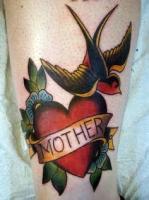 An updated repost appropriate for Mother’s Day.
An updated repost appropriate for Mother’s Day.
Sailors choose their tattoos for various reasons. Among the most popular sailor tattoos are anchors, hearts, and swallows. Not infrequently, “Mom” also made an appearance as a reminder of loved ones and home. On Mother’s Day, it seems worthwhile to look at sailors’ tattoos that reminded them of “Mom.”
Remy Melina, in the Live Science blog, writes about the popularity of “I Love Mom” tattoos: The “I Love Mom” tattoo first became popular during World War II. As they traveled around the world, U.S. Navy sailors got tattoos to document their achievements and memories. Tattoo parlors began to pop up near military bases and patriotic tattoos came into vogue, according to John Gray’s book “I Love Mom: An Irreverent History of the Tattoo.”
Aside from wanting to express their patriotism, the homesick sailors started to request “mom” or “mother” tattoos as a sentimental reminder of home.
 Norman Keith Collins, who earned the nickname Sailor Jerry while in the Navy, designed the “I Love Mom” tattoo, according to a book of letters between fashion designer Donald Edward Hardy and Collins titled, “Sailor Jerry Collins: American Tattoo Master.”
Norman Keith Collins, who earned the nickname Sailor Jerry while in the Navy, designed the “I Love Mom” tattoo, according to a book of letters between fashion designer Donald Edward Hardy and Collins titled, “Sailor Jerry Collins: American Tattoo Master.”
Sailor Jerry died in 1973, but his memory lives on a spiced rum that bears his nickname. The Sailor Jerry site has commentary on “Mom” and tattoos.
Anchors — At sea, the anchor is the most secure object in a sailor’s life, making it the perfect representation of stability. This is why you’ll often see them emblazoned with “Mom” or the name of a sailor’s sweetheart (the people who keep them grounded).
 Hearts — A sailor staring down a long stint at sea- including the possibility of not returning home often wanted a heart to keep his loved ones close. Sometimes these hearts were just images. Other times, they read “Mom” or featured the name of a special girl.
Hearts — A sailor staring down a long stint at sea- including the possibility of not returning home often wanted a heart to keep his loved ones close. Sometimes these hearts were just images. Other times, they read “Mom” or featured the name of a special girl.
Swallows — In addition to indicating that a sailor had sailed 5000 miles, swallows are also associated with the idea of return. This “return” symbolism is rooted in two ideas. The first was the swallow’s famous migration pattern, always returning home to San Juan Capistrano. Second, it was believed that if a sailor dies at sea, birds carry his soul home to heaven.
